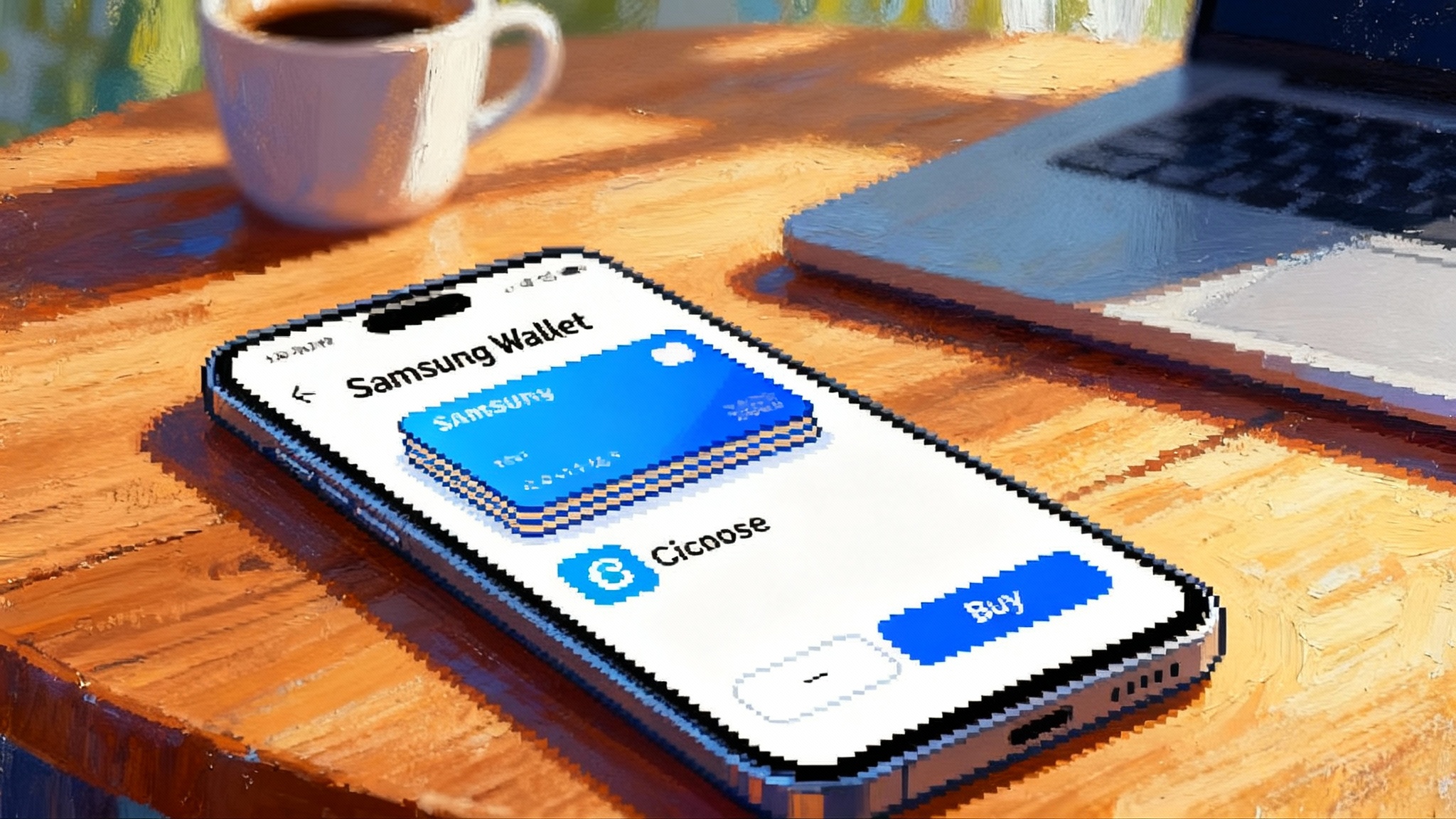Galaxy Onchain: Samsung and Coinbase flip crypto on for 75M
On October 3, Samsung expanded its Coinbase partnership and put a system-level crypto wallet one tap away for more than 75 million Galaxy owners in the United States. Here is how device-native wallets will reshape onboarding and payments.

Breaking: Crypto just became a default mobile feature
If you want to understand the next era of web3 distribution, look at your lock screen. On October 3, Samsung moved crypto from a downloadable app to a default feature by expanding its Coinbase partnership for Galaxy phones in the United States. In plain terms, crypto is graduating from a side app to a system capability. Samsung’s Oct 3 announcement makes it official.
This matters because distribution shifts tend to reshape industries. Music went from CDs to iTunes to streaming when distribution moved from stores to software to system-level search and autoplay. Payments jumped when cards became stored in phones, then jumped again when tap to pay arrived at checkout. Crypto has waited for a similar leap. It starts when a wallet is not just installed by enthusiasts but included by default, with payment rails built in, perks layered on, and identity checks compressed into a few guided taps. We have already seen how chat native crypto goes mainstream when distribution lives where users already are.
The bundle: wallet, onramp, perks, and card rails
The playbook Samsung and Coinbase are running is a bundle designed to lower the number of steps between curiosity and first transaction.
- Device-native wallet: Samsung Wallet lives on the phone, next to your cards, passes, and keys. That makes crypto feel like one more tile in your daily money hub rather than a separate hobby.
- Onramp through Samsung Pay: Funding an exchange account becomes familiar because Samsung Pay behaves like any saved card. No switching apps, no typing card numbers. The payment method is already trusted on the device you use to buy coffee.
- Perks through Coinbase One: New Galaxy users receive a free trial that waives select trading fees, boosts staking rewards, and includes priority support. Perks are not just marketing. They reduce the cognitive and monetary cost of trying something new.
- Card rails tied to exchanges: The moment you can buy crypto with the same cards you use everywhere else, the onramp stops feeling exotic. It becomes a standard checkout. Expect more bank and network integrations to follow. The goal is simple: one familiar pay button that funds both dollars and digital assets.
Why this combination is powerful: it reduces drop-offs. Every extra screen in a sign-up flow is a leaky pipe. Bundling cuts the leaks.
KYC compression: from ten minutes to two
Know Your Customer checks are a necessary step that often turns a maybe later into a never. Device-native flows can compress that without relaxing compliance. Here is how that looks on a Galaxy phone:
-
Samsung Wallet kicks off an identity flow with device biometrics. The user never types a password.
-
The phone pre-fills legal name and address from stored data the user already trusts, then requests a quick selfie match and a scan of a driver’s license.
-
Coinbase’s compliance checks run behind the scenes, the same way a credit card authorization runs when you tap to pay. If extra verification is needed, the device presents it as a single, guided card instead of an unfamiliar web form.
-
On approval, the wallet offers an instant first action. Buy 20 dollars of a stablecoin. Claim a starter reward. Set an auto-buy rule. The goal is to turn approval into action inside the same minute.
The mechanism is not magic. It is orchestration. Phones are good at collecting high quality signals like liveness, secure element storage, and consistent device identifiers with user permission. Exchanges are good at risk checks and regulatory reporting. A device-native flow combines the two into one guided hallway.
Stablecoins become the star of everyday spending
When you compress onboarding and add a familiar pay button, the asset most people try first is not a volatile token. It is a stablecoin that acts like a digital dollar. The natural use cases follow.
- Everyday checkout: If Samsung Pay can fund a Coinbase purchase in a few taps, the next step is mapping that flow to a checkout. Start with online buys and subscriptions. Move to in-store once the terminals and policies align.
- Remittances: A stablecoin allows a family in the United States to send money to relatives abroad without waiting days. Device-native flows remove the friction of addresses and networks, presenting contacts instead of hex strings.
- Bill pay and savings: A user could park part of their balance in a yield-bearing stablecoin through a regulated product, then move it back to dollars when needed. The key is one wallet and one set of buttons.
Stablecoins win distribution battles because they behave like familiar money while riding new rails. As more wallets come preloaded, the network effect shifts from traders to households. For policy and market context, see how stablecoins go mainstream.
The L2 funnel: why traffic will land on Base and friends
If the onramp is a familiar pay button, the runway is a low-fee network. Coinbase has a strong incentive to route new flows to Base and other low-cost layer 2 networks. It makes onchain actions practical for small amounts and reduces support tickets about fees.
Expect Samsung’s default path to look like this: dollars to stablecoins, then settlement on a layer 2, with on-device prompts that hide addresses and gas entirely. Account abstraction can power smart accounts that handle transaction fees in the background. In many cases the app or merchant can sponsor gas, so the first-time user never sees a fee meter at all.
This is not speculation in a vacuum. Coinbase has said the partnership will extend beyond the United States, with a clear emphasis on easy access and lower friction. Coinbase’s partner update points in that direction.
Tap to pay crypto: from demo to deployment
Here is the likely path for tap to pay using crypto balances.
-
Phase 1: Online and in-app settlement. Users pay with a stablecoin balance at ecommerce checkout. The merchant receives dollars through a processor that handles conversion. No terminal updates needed.
-
Phase 2: Tokenized card numbers. The wallet maps a stablecoin balance to a network token that rides the existing card rails. Terminals think it is a regular card. The wallet handles conversion to a stablecoin under the hood.
-
Phase 3: Native onchain at the terminal. This requires updated point of sale software. The phone presents an invoice over near field communication. The wallet pays on a low-fee chain. Proof of payment is instant. Merchants settle to dollars daily.
-
Phase 4: Offline-ready payments. The phone signs a spendable allowance for small amounts that the terminal validates later. Think of it like exact change in a secure envelope that gets checked in when the connection returns.
The milestones to watch are simple: the first big-box retailer to support crypto at checkout online, then the first network-blessed tokenization path that lets a stablecoin fund a tap without the word crypto ever appearing on screen. For a retail adoption parallel, study how fee-free Bitcoin for Main Street changed conversion and repeat use.
Global rollouts: what other manufacturers will do
Samsung’s move forces a response. Other original equipment manufacturers will follow familiar playbooks.
- Asia: Chinese and Indian Android giants will lean on domestic payment networks and local exchanges. Expect bundled promotions tied to bank transfers rather than cards, given local norms and rules.
- Europe: Privacy-first identity flows will draw on electronic identification and open banking, so the first buy is an account-to-account transfer rather than a card. This keeps fees down and compliance centralized.
- Latin America: Expect a tilt toward stablecoins as inflation hedges. Telecom bundles that include wallet perks with phone plans are likely. Data-free or zero-rating for wallet actions could show up.
The hard part is not code. It is commercial sequencing. You need the bank, the network, the exchange, and the handset maker to align on who owns support, fees, and chargeback risk. Samsung and Coinbase have shown the template. Others will copy the sequence.
Apple and Google: the likely countermoves
Apple will protect its user experience and integrate only when the trust and compliance bar is met. The most likely move is to treat a large exchange or a regulated stablecoin issuer as a feature inside Apple Wallet. Apple already has cards, transit, and keys in one place. A token balance could appear as one more pass, with purchases flowing through Apple Pay the way transit cards do today. Apple can negotiate strong consumer protections and take a platform fee for value-added services. It will avoid speculative branding and focus on utility.
Google will likely move faster on developer tools. Expect new wallet application programming interfaces that let approved partners present a crypto balance as a payment option in Android checkout, with the device handling identity and risk signals. Google Wallet can aggregate multiple approved providers so users pick once and see that preference across apps. That keeps Google in a routing role rather than a balance holder.
Neither company will try to be an exchange. Both will try to make their phones the best place to use one. The winning story for them is financial features inside a privacy-preserving, developer-friendly wallet that plays nicely with the systems people already use.
Friction points to solve next
- Fraud and chargebacks: Card rails have consumer protections that crypto networks do not. Expect purchase coverage and insurance-like warranties to be packaged with membership tiers so a mistaken or unauthorized payment can be refunded.
- App store policy: Clear guidance on what a wallet can display and how fees are shown will matter. A consistent set of rules reduces developer uncertainty and speeds integration.
- Tax and reporting: People need a simple tax report for small purchases and transfers. If the first year’s tax experience is painful, retention suffers. Expect wallets to auto-tag many transactions as small personal payments below thresholds and export the rest.
- Merchant acceptance: Processors must make settlement choices simple. Merchants should see three buttons in their dashboard: settle to dollars now, hold a percentage in stablecoins, or auto-convert later. Simplicity wins.
- Education inside the wallet: Tooltips, plain-language risk disclosures, and practice modes reduce support load. A test purchase feature for one dollar can turn a skeptic into a customer.
The metrics that matter in the device-native era
If crypto is now a system feature, success will show up in a handful of numbers. Here is the scorecard to watch.
- Activation rate: Of eligible Galaxy phones, what share turns on crypto inside Samsung Wallet within 30 days of availability. A strong first wave would be in the low double digits. Anything below five percent signals friction.
- First-trade conversion: Of those who activate, what share completes a first buy or transfer within the same session. The closer this gets to 60 percent, the better the funnel.
- Wallet retention: Thirty-day and ninety-day return rates for users who made a first action. Watch whether perks drive shallow trials or repeat behavior. A durable curve will have a gentle slope rather than a cliff after the free period.
- Onchain transactions per device: Not just buys and sells. Track actual transfers, contract interactions, and payments. If this number grows past five per month for mainstream users, real utility is taking hold.
- Share of stablecoin volume: How much activity is anchored to digital dollars. Rising share usually means payments are becoming everyday rather than speculative.
- Layer 2 settlement share: The percentage of onchain activity that happens on low-fee networks. A high share means fees and speed are no longer the bottleneck.
- Tap to pay readiness: Number of major processors and networks that support tokenized flows tied to stablecoin funding. This is the bridge to real-world checkout.
What builders and brands should do now
- Consumer apps: Add a pay with wallet option that accepts both dollars and stablecoins. Let the device choose the cheapest safe route. Start with non-refundable digital goods where chargeback risk is low.
- ** Merchants:** Pilot stablecoin settlement for online orders that have repeat purchase patterns, like subscriptions and top-ups. Measure refund rates and support tickets. If both drop, scale.
- Fintechs: Treat account abstraction as a product feature. Offer sponsored gas for new users up to a clear limit each month. Make the fee schedule human by showing round numbers.
- Exchanges and wallets: Strike local partnerships with banks and carriers ahead of handset rollouts. Your fastest wins come from solving support assignments and refund rules before launch, not after.
- Developers: Build small. Start with a single use case. Use the device’s identity prompts rather than inventing your own. Let the phone do the heavy lifting for security and payments.
Also watch how institutions are moving onchain in parallel, including the RWA wave covered in Wall Street Goes Onchain.
The bottom line
Samsung turning Coinbase into a system-level experience on Galaxy phones signals the arrival of a new distribution era for crypto. When a wallet ships with the device, an onramp sits inside the same app as your cards, and perks remove early friction, the path from interest to action stops being a maze. The next competition will not be who has the flashiest trading view. It will be who makes a safe one-dollar payment feel as simple as a tap. Once that feels normal, the rest of the onchain economy follows.
Crypto’s new front door is the phone you already carry. The winners will be the teams who accept that reality, build for it, and measure what matters.








